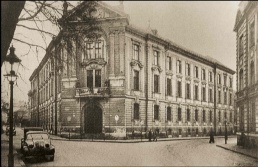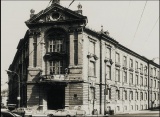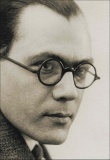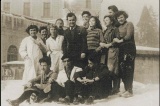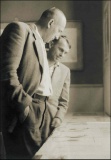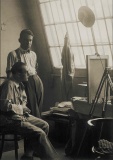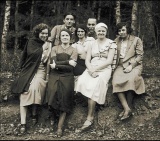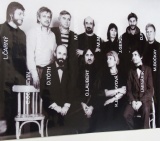Difference between revisions of "School of Arts and Crafts, Bratislava"
| Line 46: | Line 46: | ||
==Literature== | ==Literature== | ||
; Books | ; Books | ||
| − | * Iva Mojžišová, ''Škola moderného videnia - | + | * Iva Mojžišová, ''Škola moderného videnia - bratislavská ŠUR 1928-1939'', Bratislava: Artforum & Slovak Design Center, 2013, 216 pp. ISBN: 9788081500107 (in Slovak) [http://www.sdc.sk/knihy--skola-moderneho-videnia], [http://vydavatelstvo.artforum.sk/nase-knihy/prekladove/25058/], [http://www.artforum.sk/userdata/catalog/previews/113559.pdf Preview], [http://www.sdc.sk/swift_data/source/publikacie/knihy/sur/TS_SUR%20_Mojzisova.pdf Preview]. |
; Articles | ; Articles | ||
Revision as of 17:12, 27 July 2013
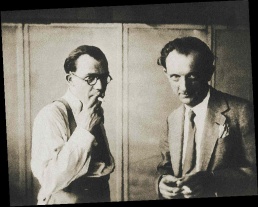
In 1920, Josef Vydra, founded the Society of Art Industry orientated towards the production and promotion of modern design. The Society intended to organise production workshops and enterprises, but the generally low level of Slovak industry resulted in it being dissolved in 1924. Josef Vydra later concentrated on educational activities. In 1928 on his initiative the School of Arts and Crafts [Škola umeleckých remesiel] (1928-1939) was founded in Bratislava with support from the Chamber of Commerce and Industry to provide evening courses in drawing and advertising. Later there were departments for textiles, metal, wood, ceramics, photography, typography, decorative painting and window-dressing. It quickly became one of the most progressive educational institutions in the area of utility creative art disciplines in Europe during the interwar period. Study in specialized departments was preceded by preliminary basic elementary courses in drawing, surface and space composition, colour harmony, modelling and lettering. In reality, this already involved an application of the Bauhaus method. The school's intention was also to integrate national folk craft traditions into modern production. The teachers included avant-garde artists Ľudovít Fulla, Mikuláš Galanda, Jaromír Funke and lecturers such as László Moholy-Nagy, Jan Tschichold, Kállai, Hannes Meyer and others. They drew their inspiration from Analytical Realism, Constructivism and the poetic fantasy of children's art - combining all these influences with a high level of craft skills and with folk art traditions going back over hundreds of years. In mid-1930s the school was attended by 200 students and the teaching staff counted some twenty members. The students were of Slovak, Czech, German and Hungarian nationalities and, in time, they also came from Poland, Yugoslavia, Germany and Bulgaria. After Czech professors were forced to leave Slovakia, Vydra persuaded Fulla to take up the direction of the School after him in the hope that continuity would thus be preserved. It was for a very short time only-ten months. In October 1939 the School of Applied Arts was closed. [1] [2]
- Photography
- Jaromír Funke, head of photography department since 1931. He considered studying at the Bauhaus, but in the end gave priority to teaching in Bratislava.
- Irena Blühová.
- Typography
- Zdeněk Rossmann, With him, Vydra school's impact had grown considerably and within two years its influence had penetrated several Slovak printing presses. During his stay in Bratislava he prepared a book on the utilization of lettering and photography in advertising, published as Písmo a fotografie v reklamě, Index, Olomouc, 1938. He also worked at Slovenská grafia and nová bratislava journals.
- Architecture
- Painting and graphic art
- Ľudovít Fulla. He applied constructive typography and graphic design in jacket designs (books and magazines), and a journal Slovenská grafia.
- Mikuláš Galanda, from 1930 (from 1933 as professor).
- Theatre
- Frantisek Tröster, scenographer. Head of metal-working department at the School (1934-38).
- Film
- Karol Plicka. Came during the last years of the School's existence. Later in 1938 in Bratislava he opened the first film school in Czechoslovakia.
- Applied arts
- Júlia Horová, ceramics artist.
Images
See also
Literature
- Books
- Iva Mojžišová, Škola moderného videnia - bratislavská ŠUR 1928-1939, Bratislava: Artforum & Slovak Design Center, 2013, 216 pp. ISBN: 9788081500107 (in Slovak) [3], [4], Preview, Preview.
- Articles
- Francis A. Taylor, article on his impressions of a visit to the Bratislava School, Journal of the Royal Society of Arts, no. 4332, 1935; "Současné školy umění a řemesel na kontinente" [Contemporary School of Arts and Crafts on the Continent], Výtvarná výchova, Prague, vol. 2, no. 3, 1936, pp. 11-29 (Czech).
- V. Vydra, "Počiatky prvej umeleckej školy na Slovensku", Výtvarný život, Bratislava, 1958, p 300. (Slovak)
- Tomáš Štrauss, "Slovenský variant moderny (ŠUR Bratislava 1928-1938)" [A Slovak Variant of Modernism]. Umění a remesla, 1978, no. 3, pp 10-19; "Die Slowakische Variante der Moderne", Bauhauskolloquium von 27. bis 29. Juni 1979 in Weimar, WissenschaftlicheZeitschriftder Hochschule Architektur und Bauwesen, Weimar, vol. 26, nos. 4-5, 1979, pp 405-13. [5]
- Fero Tomík, "J. Funke a ŠUR v Bratislave" [J. Funke and the School of Arts and Crafts in Bratislava]. In: Aktuálnost československé meziválečné fotografie. Dum umění města Brna, Brno 1979. pp 54-61.
- Maria Pötzl-Malikova, "Die Kunstgewerbeschule in Preßburg 1928-1939. Zur Ausstrahlung der Bauhaus-Ideen in der Slowakei", Vorträge der Tagungen des Collegium Carolinum Bad Wiesse vom 23. bis 25. November 1979 und vom 28. bis 30. November 1980, R. Oldenbourg Verlag, Munich/Vienna, 1982, pp 201-324.
- Iva Mojžišová, "Die personliche Beziehungen zwischen den Angehörigen des Bauhauses und der Kunstgewerbeschule in Bratislava in Lichte neuentdeckter Dokumente", 4. internationales Bauhauskolloquium vom 24. bis 25. Juni 1986, in Wissenschaftliche Zeitschrift der Hochschule fur Architektur Bauwesen Weimar, vol. 33, nos. 4-5-6, 1987, pp 33. (German)
- Iva Mojžišová, "Škola umeleckých remesiel v Bratislave a Bauhaus", ARS, No. 2 (1990), Bratislava, pp 42-45. (Slovak)
- Iva Mojžišová, "Osobné vzťahy medzi členmi Bauhausu a Školy umeleckých remesiel v Bratislave vo svetle novonájdených dokumentov", Profil (1993), Bratislava, pp 1-2. (Slovak)
